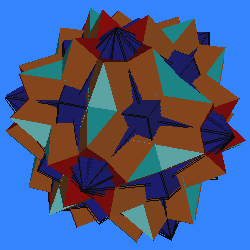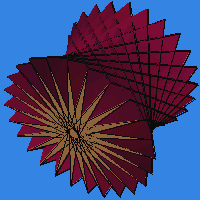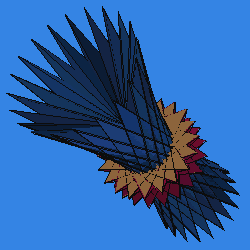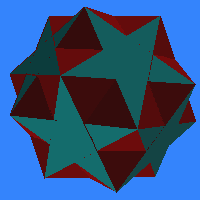Uniform Polyhedra
 In
a uniform polyhedron, every face is required to be a regular polygon, and
every vertex is required to be identical, but the faces need not be identical.
Thus these are semiregular in the same way that the Archimedean
solids are, but the faces and vertex figures need not be convex. At
left is the rhombidodecadodecahedron, (5, 4, 5/2, 4) in which a pentagon,
a square, a pentagram, and another square meet at each vertex. In the nonconvex
cases, some faces are intersected by other faces, and so are only partly
visible.
In
a uniform polyhedron, every face is required to be a regular polygon, and
every vertex is required to be identical, but the faces need not be identical.
Thus these are semiregular in the same way that the Archimedean
solids are, but the faces and vertex figures need not be convex. At
left is the rhombidodecadodecahedron, (5, 4, 5/2, 4) in which a pentagon,
a square, a pentagram, and another square meet at each vertex. In the nonconvex
cases, some faces are intersected by other faces, and so are only partly
visible.
There are 75 uniform polyhedra, plus an infinite number of prisms and antiprisms. Uniform polyhedra can be organized in the following taxonomy. Nine of these are regular and the remainder are semi-regular.
- Convex Uniform Polyhedra:
- Platonic solids (these 5 are regular)
- Archimedean solids (there are 13 of these)
- Convex prisms and antiprisms (two infinite families)
- Nonconvex Uniform Polyhedra:
- Kepler-Poinsot polyhedra (these 4 are regular)
- Nonconvex uniform polyhedra (there are 53 of these)
- Nonconvex prisms, antiprisms, and crossed antiprisms (three infinite families)
The 53 nonconvex uniform polyhedra
These are analogous to the Archimedean solids in that they provide a wide variety of interesting and attractive forms, many of which can be related to others by operations such as truncation or snubbing. For example, starting from the great dodecahedron, truncating the corners at a depth which gives regular decagons produces the great truncated dodecahedron. Truncating further --- at the edge midpoints --- gives the dodecadodecahedron, consisting of 12 pentagons and 12 pentagrams in parallel planes. The rhombidodecadodecahedron (illustrated at the top of the page) is closely related, but also includes thirty squares (in the planes of the rhombic triacontahedron). If each of the squares is sliced diagonally into two triangles (maintaining the same handedness) and everything is rotated slightly so the triangles become equilateral, the result is a snub dodecadodecahedron.The snub solid just derived is chiral, like the two Archimedean snubs. Among the uniform polyhedra there are also reflexible snubs, for example the snub disicosidodecahedron. The essence of "snubness" here is that some of the faces (all the triangles) have the property that there is no rotation of the whole polyhedron which brings the whole back on to itself and also brings a given triangle back to itself. So the triangles are snub faces, but they come in pairs in such a way that the entire solid is reflexible. A similar property holds for the retrosnub disicosidodecahedron.
Nine of the 53 are "hemihedra" --- the infix "-hemi-" in their name indicates that some of the faces span a complete hemisphere (if you project their edges on to a surrounding sphere). This means that these faces pass through the center of the polyhedron. For example, the small icosihemidodecahedron consists of 20 triangles and six decagons whose centers coincide at the center of the polyhedron. A most interesting example in this class is the tetrahemihexahedron, also called the one-sided heptahedron, which is the only nonprismic uniform polyhedron with an odd number of sides: four triangles plus three squares. The hemihedra have a number of special properties because they fall within the class of quasi-regular polyhedra.
One particularly interesting uniform polyhedron is the great snub disicosidisdodecahedron. It has eight faces per vertex (4, 5/2, 4, 3, 4, 5/2, 4, 3) and is the only one with more than six faces per vertex. All three types of faces come in coplanar pairs. The squares pass through the center, so it has no finite dual. The squares are snub faces because there is no rotation which brings the whole back to itself and some square back to itself.
The duals to the uniform polyhedra are facially regular, meaning that they are composed of a single type of face, every face in the same relation to the whole, and their vertex figures are regular polygons. Because each dual has a different type of nonregular face, and the faces partially obscure each other, it can be unclear at first that a visible facet is not a complete face. In order to know what to look for, I have included a picture of the complete dual face for each of these polyhedra. Looking at a face alone lets one know what to look for in the whole and so lets one understand more clearly how the dual is constructed. As an example, the small rhombicube (8, 4, 8, 4) has the small rhombihexacron as its dual. It is easier to understand the latter after seeing that the face is a butterfly-shaped crossed quadrilateral, which appears as two triangles. However, the point at which the two triangles join is just an edge-crossing, not a vertex of the polyhedron and so does not correspond to a face of the underlying primal.
In a compound of a nonconvex uniform solid and its dual, the dual often hides most or all of the uniform solid, so I have rendered these compounds with the dual polyhedron partially transparent. This lets you look through it to see otherwise hidden structure. (However not all VRML viewers render partially transparent surfaces correctly, so you may see them as solid.) In their compound, partial transparency lets you see how the dual completely surrounds the inner primal.
 Here
are a few attractive, never-before-seen compounds which you might like.
Each shows a nonconvex polyhedron with its dual:
Here
are a few attractive, never-before-seen compounds which you might like.
Each shows a nonconvex polyhedron with its dual:
- compound of snub disicosidodecahedron and dual
- compound of small triambic icosidodecahedron and dual
- compound of small icosic icosidodecahedron and dual
- compound of great dodecicosidodecahedron and dual
- compound of great stellated truncated dodecahedron and dual
- compound of great vertisnub icosidodecahedron and dual
Prisms, antiprisms, and crossed antiprisms
Starting with any nonconvex regular polygon as base, it is possible to construct a prism or antiprism analogous to the case of a convex base. For example the pentagrammatic prism and pentagrammatic antiprism are based on the pentagram. The prism (5/2, 4, 4) has a pentagram and two squares meeting at each vertex; the antiprism (5/2, 3, 3, 3) has a pentagram and three triangles meeting at each vertex. At
left is an antiprism based on the {25/12}
polygon. Although prism symmetry is usually considered a "lower" symmetry
than other polyhedral symmetry, examples of this sort show that at high
order they can be very attractive. (Be sure and fly through this and the
following compound, along their axes.)
At
left is an antiprism based on the {25/12}
polygon. Although prism symmetry is usually considered a "lower" symmetry
than other polyhedral symmetry, examples of this sort show that at high
order they can be very attractive. (Be sure and fly through this and the
following compound, along their axes.)
There is also a kind of crossed antiprism, e.g., the pentagrammatic crossed antiprism also (5/2, 3, 3, 3), but the vertex figure is a butterfly-shaped (crossed) quadrilateral and the triangular faces cross the n-fold axis. The first type of antiprism can be constructed on any base n/m, but the crossed antiprism can only be constructed on a base n/m where 2< n/m < 3.
To view any of an infinite number of such prisms, antiprisms, and crossed antiprisms, use the prism generator page which allows you to type in any desired n and m and it will create a never-before-seen virtual object for you on the fly.
 Dual
to prisms and antiprisms are dipyramids and trapezohedra on nonconvex bases.
In the case of crossed antiprisms, the dual trapezohedron is composed of
concave quadrilaterals. At right is the compound
of a {20/7} crossed antiprism and its dual concave trapezohedron. The
following triples illustrate some simpler examples, where the second line
in each case is the dual.
Dual
to prisms and antiprisms are dipyramids and trapezohedra on nonconvex bases.
In the case of crossed antiprisms, the dual trapezohedron is composed of
concave quadrilaterals. At right is the compound
of a {20/7} crossed antiprism and its dual concave trapezohedron. The
following triples illustrate some simpler examples, where the second line
in each case is the dual.
- prism:
- antiprism:
- pentagrammatic antiprism
- pentagrammatic trapezohedron (face)
- compound of pentagrammatic antiprism and dual
- crossed antiprism:
History
The Platonic solids have been known since antiquity. The Archimedean solids are believed to have been the subject of a book by Archimedes, though some were known much earlier. Kepler rediscovered them and realized that the prisms and antiprisms belong in the same semiregular class. Kepler (1619) and Poinsot (1810) described the regular nonconvex polyhedra. In 1881, A. Badoureau and J. Pitsch discovered 41 of the semiregular nonconvex polyhedra, and the remaining 12 were discovered by H.S.M. Coxeter and J.C.P. Miller in the 1930s.
 References:
The first complete list is in the 1953 paper by Coxeter et al. but the
list wasn't proven to be complete until Skilling's 1975 computer search.
Wenninger's 1971 book shows paper models and templates for them all, and
his 1983 book does the same for their duals. As far as I know, the compounds
and the high order prisms and antiprisms have not been illustrated in any
previous publication.
References:
The first complete list is in the 1953 paper by Coxeter et al. but the
list wasn't proven to be complete until Skilling's 1975 computer search.
Wenninger's 1971 book shows paper models and templates for them all, and
his 1983 book does the same for their duals. As far as I know, the compounds
and the high order prisms and antiprisms have not been illustrated in any
previous publication.
The software I used to generate these is an adaptation of Maeder's adaptation
of Har'El's Kaleido program. The names
for these polyhedra and their duals are largely the creations of Norman
Johnson whose forthcoming book on uniform polyhedra contains a great deal
more information. The names used here are based on his latest suggestions
and differ in some places from his earlier terminology, used in the above
works of Wenninger.